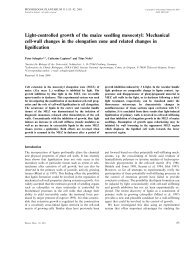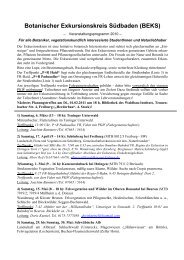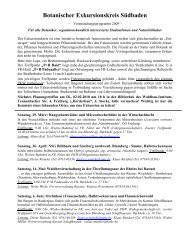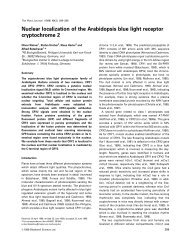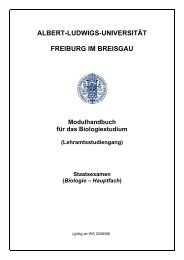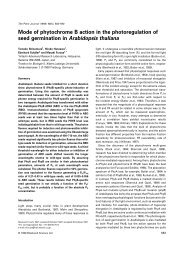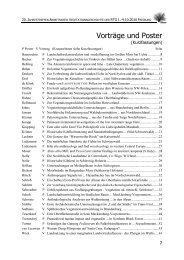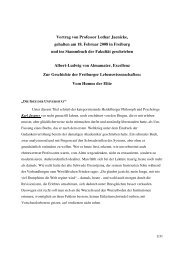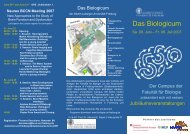SEXUAL SIZE DIMORPHISM AND MORPHOLOGICAL EVIDENCE ...
SEXUAL SIZE DIMORPHISM AND MORPHOLOGICAL EVIDENCE ...
SEXUAL SIZE DIMORPHISM AND MORPHOLOGICAL EVIDENCE ...
Create successful ePaper yourself
Turn your PDF publications into a flip-book with our unique Google optimized e-Paper software.
140 DIEGO SANTIAGO-ALARCON <strong>AND</strong> PATRICIA G. PARKER<br />
have been altered and are composed of habitats<br />
not found on other uninhabited islands. These<br />
differences among islands might represent areas<br />
of strong selection pressure for endemic doves.<br />
Nonetheless, because of high gene flow among<br />
southern island populations, observed differences<br />
are more likely the result of phenotypic<br />
plasticity.<br />
The ecological causes of sexual size dimorphism<br />
in the Galápagos Dove are difficult to<br />
identify because there are limited data for this<br />
species (Grant and Grant 1979). However,<br />
morphological differences are likely not the<br />
result of a single factor, but rather the result of<br />
multiple interacting factors (Moore 1990,<br />
Owens and Hartley 1998, Clegg and Owens<br />
2002).<br />
ACKNOWLEDGMENTS<br />
We thank all the people who provided help during<br />
the different stages of the field season, particularly N.<br />
Whiteman, J. Bollmer, G. Jiménez, J. Merkel, J.<br />
Rabenold, and N. Gottdenker. We are grateful to the<br />
staff of the Charles Darwin Research Station for<br />
their invaluable help and logistical support during the<br />
course of this study, especially P. Robayo. We thank<br />
N. Cuevas and J. Freire who helped with dove<br />
sampling at Tortuga Bay, Santa Cruz. Permits for<br />
sample collection were provided by the Galápagos<br />
National Park authorities. B. Loiselle, R. Ricklefs,<br />
and two anonymous reviewers made helpful comments<br />
and suggestions on earlier versions of this<br />
manuscript. S. Siers helped in the preparation of the<br />
figures. Financial support was provided by The<br />
Whitney R. Harris World Ecology Center, The Saint<br />
Louis Zoo FRC# 05-2, and E. Des Lee Collaborative<br />
Vision in Zoological Research.<br />
LITERATURE CITED<br />
BAPTISTA, L. F., P. W. TRAIL, <strong>AND</strong> H. M. HORBLIT.<br />
1997. Family Columbidae (pigeons and doves),<br />
p. 60–243. In J. del Hoyo, A. Elliot, and J.<br />
Sargatal [EDS.], Handbook of the birds of the<br />
world. Vol. 4. Sandgrouse to cuckoos. Lynx<br />
Edicions, Barcelona.<br />
BOAG, P. T. 1981. Morphological variation in the<br />
Darwin’s finches (Geospizinae) of Daphne Major<br />
Island, Galápagos. Ph.D. dissertation,<br />
McGill University, Montreal.<br />
BOAG, P. T. 1983. The heritability of external<br />
morphology in Darwin’s ground finches (Geospiza)<br />
on Isla Daphne Major, Galápagos. Evolution<br />
37:877–894.<br />
BOLLMER, J. L., T. SANCHEZ, M.D.CANNON, D.<br />
SANCHEZ, B.CANNON, J.C.BEDNARZ, T. DE<br />
VRIES, M.S.STRUVE, <strong>AND</strong> P. G. PARKER. 2003.<br />
Variation in morphology and mating system<br />
among island populations of Galápagos Hawks.<br />
Condor 105:428–438.<br />
Santiago-Alarcon, Diego, 2008, UMSL, p. 35<br />
BOLLMER, J. L., N. K. WHITEMAN, M.D.CANNON,<br />
J. C. BEDNARZ, T. DE VRIES, <strong>AND</strong> P. G.<br />
PARKER. 2005. Population genetics of the<br />
Galápagos Hawk: genetic monomorphism within<br />
isolated populations. Auk 122:1210–1224.<br />
BOWMAN, R. L. 1961. Morphological differentiation<br />
and adaptation in the Galápagos finches. University<br />
of California Publications in Zoology<br />
58:1–302.<br />
BUTLER, M. A., T. W. SCHOENER, <strong>AND</strong> J. B. LOSOS.<br />
2000. The relationship between sexual size dimorphism<br />
and habitat use in Greater Antillean<br />
Anolis lizards. Evolution 54:259–272.<br />
CLEGG, S. M., <strong>AND</strong> I. P. F. OWENS. 2002. The ‘island<br />
rule’ in birds: medium body size and its<br />
ecological explanation. Proceedings of the Royal<br />
Society of London Series B 269:1359–1365.<br />
COLEMAN, M., <strong>AND</strong> R. J. ABBOTT. 2003. Possible<br />
causes of morphological variation in an endemic<br />
Moroccan groundsel (Senecio leucanthemifolius<br />
var. casablancae): evidence from chloroplast<br />
DNA and random amplified polymorphic<br />
DNA markers. Molecular Ecology 12:423–434.<br />
CURRY, R. L. 1988. Group structure, within group<br />
conflict and reproductive tactics in cooperatively<br />
breeding Galápagos Mockingbirds, Nesomimus<br />
parvulus. Animal Behaviour 36:1708–1728.<br />
CURRY, R. L. 1989. Geographic variation in social<br />
organization of Galápagos mockingbirds: ecological<br />
correlates of group territoriality and<br />
cooperative breeding. Behavioral Ecology and<br />
Sociobiology 25:147–160.<br />
CURRY, R. L., <strong>AND</strong> P. R. GRANT. 1989. Demography<br />
of the cooperatively breeding Galápagos Mockingbird,<br />
Nesomimus parvulus, in a climatically<br />
variable environment. Journal of Animal Ecology<br />
58:441–463.<br />
FAIRBAIRN, D. J. 1997. Allometry for sexual size<br />
dimorphism: pattern and process in the coevolution<br />
of body size in males and females.<br />
Annual Review of Ecology and Systematics<br />
28:659–687.<br />
FRIDOLFSSON, A. K., <strong>AND</strong> H. ELLEGREN. 1999. A<br />
simple and universal method for molecular<br />
sexing of non-ratite birds. Journal of Avian<br />
Biology 30:116–121.<br />
GIFFORD, E. W. 1913. Expedition of the California<br />
Academy of Sciences to the Galápagos Islands,<br />
1905–1906. Proceedings of the California Academy<br />
of Sciences 2:1–132.<br />
GOODWIN, D. 1977. Pigeons and doves of the world.<br />
Comstock, Cornell University Press, Ithaca, NY.<br />
GRANT, P. R. 2001. Reconstructing the evolution of<br />
birds on islands: 100 years of reseach. Oikos<br />
92:385–403.<br />
GRANT, P. R., I. ABBOTT, D. SCHLUTER, R. L.<br />
CURRY, <strong>AND</strong> L. K. ABBOTT. 1985. Variation in<br />
the size and shape of Darwin’s finches. Biological<br />
Journal of the Linnean Society 25:1–39.<br />
GRANT, P. R., <strong>AND</strong> K. T. GRANT. 1979. Breeding<br />
and feeding ecology of the Galápagos Dove.<br />
Condor 81:397–403.<br />
HOOD, G. [ONLINE]. 2003. PopTools. 5www.cse.<br />
csiro.au/poptools/4 (30 May 2006).



